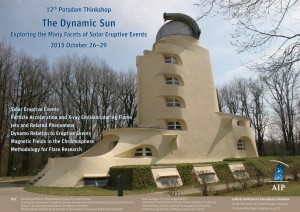Modeling of Ellerman Bombs Based on the New IRIS Observations Obtained in Mg II Lines
Arkadiusz Berlicki (Astronomical Institute, University of Wroclaw)
Abstract. Observations of Ellerman bombs (EBs) show them as small brightenings well observed in different chromospheric lines, both in the optical and UV spectral ranges (H I, Ca II, Mg II). EBs are probably a manifestation of small reconnection processes occurred in the lower solar atmosphere. H-alpha line profiles of EBs exhibit enhanced emission at line-wings even up to a few angstroms from the line core and were reported in the past as a “moustaches” phenomenon (Bruzek 1968). On the contrary, Ca II and Mg II lines emitted by EBs can be strongly enhanced also in the line cores. In our work we used new high-resolution UV spectroscopic observations obtained by the Interface Region Imaging Spectrograph (IRIS) to derive models of different EBs observed in the new flux emergence area in the AR NOAA 11850. These observations were obtained on September 24, 2013. The calibrated spectral lines of Mg II were compared with the grid of the theoretical line profiles computed with the NLTE radiative transfer codes for different EBs atmospheric models. By modifying of the solar atmospheric model we found the best fit between the theoretical spectrum and observations and thus, the most probable semiempirical models of EBs were determined. We will also discuss some global physical parameters of EBs.
Contributed Talk
